Get The Buzz – Planting for Bees
There are many reasons why bees are so very important to us, but one fact really stands out to us and makes us appreciate how hugely important our buzzy friends are:
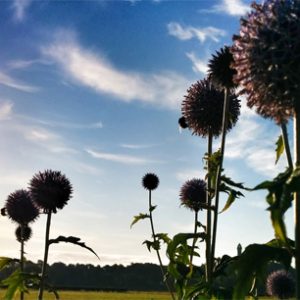
The bees loving the echinops in our garden
1. Lavender
A favourite with so many of our clients. It loves dry, sunny positions so if you don’t have the correct sort of soil in your borders consider having a pretty pot filled with lavender on a sunny corner of our patio where you can enjoy the
sights, smells and buzzy sounds from it!
2. Catmint
Nepeta is loved by cats and bees alike! It is similar to lavender with its pretty flowers and silvery blue leaves and gives off a lovely aromatic scent as you brush past.
3. Verbena
We love verbena, particularly verbena bonariensis. It grows really easily, even in our heavy clay soil and gives statuesque height to the border. You may need to give the plant a bit of support if your garden catches the wind and be warned, this plant does like to self seed. It provides beautiful winter interest if it’s not cut down in Autumn.
4. Sedum
continues to provide interest through the winter. It’s easy to split and create new plants so if you know a friend who has some then go ask for a piece now!
5. Eryngium
interest if you don’t cut it down after it has flowered.
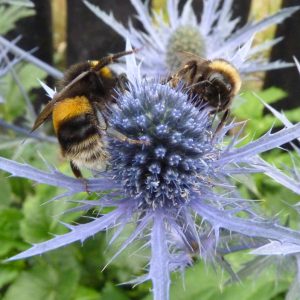
6. Buddleja
Probably best known for attracting butterflies but bees are also partial to a buddleja. The long cone-like flowers prove too irresistible for them.
7. Sunflowers
Now, who can resist the big yellow smiley face of a sun flower? It’s the perfect plant to get kids involved in gardening. Get them to have a competition with their friends to see who can grow the tallest plant and use it to explain to them the importance of encouraging bees into the garden.
8. Hebe
Hebes are a great structural shrub which can be a lovely alternative to buxus in your garden if you are looking for a rounded shape to provide an interesting form. But bees love their flowers too making it a well rounded (excuse the pun) plant for the garden.

A bee on sedum
9. Foxgloves
We regularly see foxgloves growing profusely at the sides of the road so it shows just how easy they are to grow. They will self seed furiously so once you have them you will get free plants forever. Bees just love snuggling up inside one
of the bell like flowers and having a nice big feed.
10. Heathers
Again, a plant we often see growing in the wild in Scotland and if you have acidic soil in your garden you will be able to grow these well and keep our fuzzy friends happy.
If we have whetted your appetite, then there are literally THOUSANDS of plants* which bees will love and there will be plenty to suit your garden and soil. The perfect for pollinators list published by the RHS gives you more information than you could ever wish for.
Fir Trade!
I am soooo excited. You may have noticed Santa is busy getting ready for Christmas and is making lots of appearances at garden centres, shopping centres and even on trains! There is only five weeks to go so you better get your letters written and brush up on your good behaviour. One of my favourite things about Christmas is the tree, especially trying to climb it! There are lots of questions about whether a real or artificial tree is better for the environment, which variety of real Christmas tree to get, how to stop the needles falling off etc. So as usual, I’m at hand to answer all your questions as well as give you a little Christmas Tree decoration project to do…

Daddy and I with a real Christmas tree
Real or Artificial?
Now whilst some may claim that an artificial tree is better for the environment as you re-use it every year, there is still a huge impact on the environment by making it in the first place. Most are made from PVC which, from an environmental perspective, is a pretty horrible material. When you are fed up with your artificial tree and you throw it out, it will likely linger in land-fill for CENTURIES – not a great legacy to leave behind! Also, there is the carbon footprint to consider as most of the trees are made in the Far East and have to be shipped over here.
At Vialii, we believe that a real Christmas tree is much more environmentally friendly as long as you buy it local to where it was grown and that there is a re-planting commitment for all trees that are felled. Plus they smell lovely! A good quality, freshly cut tree can last up to 6 weeks if well looked after so don’t worry that you can’t put your tree up as early as the fakers! If I’m not convincing enough, consider this…A study in 2009 (Ellipsos) concluded that a 7-foot cut tree’s impact on climate is 60 percent less than a 7-foot artificial tree used for six years.
Living Christmas Tree
You can buy a live tree (with roots) but you can only have it indoors for a very short time and you will need to keep it in a cool place as it will come out of its dormant phase (in other words wake up!) and may not survive when you plant it back outdoors in the cold. If you are putting a live tree back outside you will need to acclimatise it back into the cold. If you find a supplier of cut trees who will plant lots more trees for every one they sell we think that’s the best compromise.
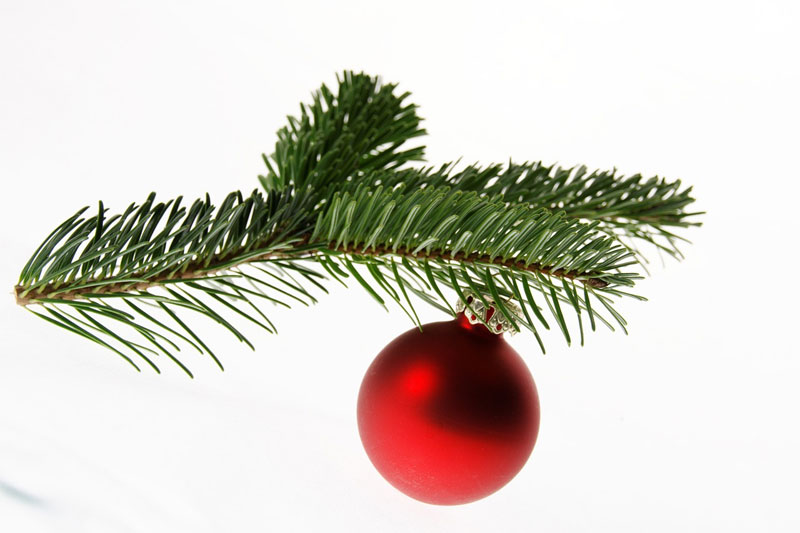
What’s the best type of Christmas tree for you?
What is the best type of real Christmas tree to buy?
OK, now that we have convinced you to get real, which variety should you opt for? Here are a few of the most common Christmas trees you will find for sale and some of their key features:
Nordmann Fir – the King of the Christmas Tree accounting for a huge 80% of UK sales. It has lovely deep green foliage on the top and blue underneath. It has lovely symmetry and shape and is less likely to drop its needles.
Norway Spruce – another popular choice and one which has a lovely smell. This one can be more likely to drop its needles so watch out and don’t buy it too early.
If you can find it, the Noble Fir is a great choice for needle loss, branch firmness, scent and the softness of the needles.
Fraser Fir – this one has a pyramid shape and soft needles which can be more family friendly. It has flat green needles and can be narrow making it a good choice to smaller spaces.
Top tips for looking after your real Christmas tree:
- Measure your space where the tree will be going (including the height) so that you buy the right size of tree (allow for a stand and a star on top!)
- Ask the retailer where the tree was grown and when it was cut.
- Give your tree a good shake. If the needles fall off then choose another.
- Lift the tree up. A freshly cut tree should feel heavy as it will have a high water content.
- Don’t buy a pre-packaged tree – you need to see it out so you can see the shape, make sure it has good symmetry, not too bare and will fit in your space. Most places will be happy to open up any that are already packed to let you see them and then re-wrap.
- Cut a centimetre or so off the trunk before bringing it in to the house to help it absorb water better.
- Choose a cooler corner of your room and make sure you water your tree EVERY day to minimise needle loss.
- Many charities sell Christmas trees so consider buying from one of these sources and spread some festive cheer.Remember to recycle your real tree once Christmas is over. Most councils will collect your tree and will then chip them and re-use the material as a mulch.
Now that I have helped you choose your Christmas tree, here is a fun project to make your own Christmas tree decoration…
Hand Print Santa Decoration
- Pencil
- Scissors
- White card
- Pink paper, card or paint
- Red paper, card or fabric
- Googly eyes
- Cotton wool
- Some ribbon, wool or string
- Glue
To make:
1. Ask your grown up to help you draw round your hand on some white card then cut it out. This will be the beard.

Draw round your hand on a piece of white card
2. Cut out an oval shaped face from the pink card (or use more of the white card and paint it pink or glue on some pink paper).
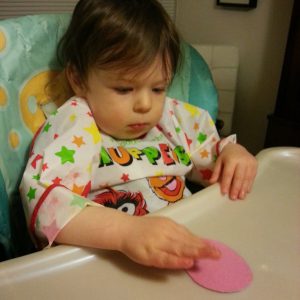
Here I am gluing some pink paper to my Santa’s head
3. Cut a hat shape from the red card (or use white card and glue on your red fabric/paper). Glue some cotton wool along the bottom of the hat and a cotton wool pom pom to the top.
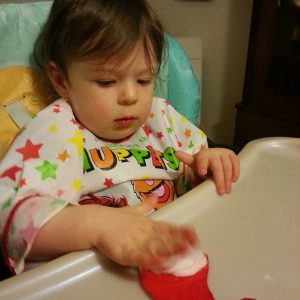
Make your santa hat. I added some red tissue paper to mine and cotton wool.
4. Glue your cut-out hand (the beard) to the bottom of the face and glue the hat to the top of the face. Glue the googly eyes onto the face and attach the ribbon so that you can hang it on your tree.
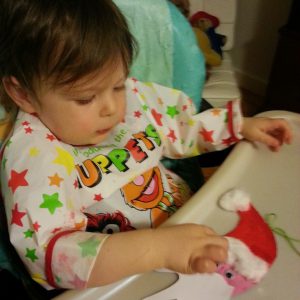
I love a googly eye!
5. Hang your beautiful hand-made decoration on your tree. Lovely for Christmas and a wonderful keep-sake.
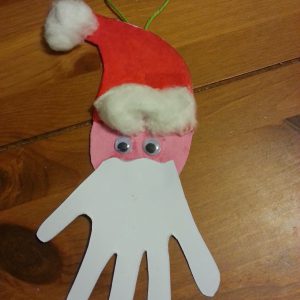
Our Santa Hand Christmas tree decoratio
Remember, don’t be naughty…I’d love to see pictures of your Christmas trees and your own hand made decorations so please send them to me.
Lulu
Thank you to Parents.com for the inspiration behind this decoration